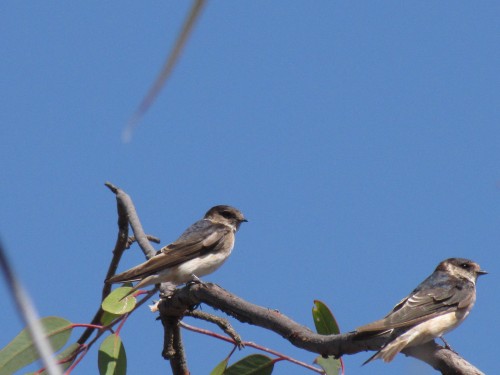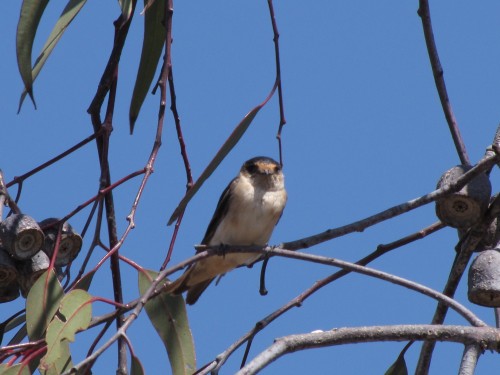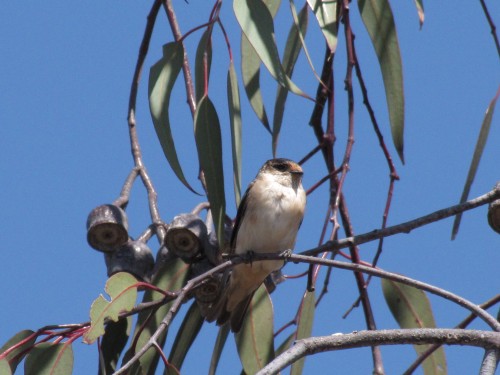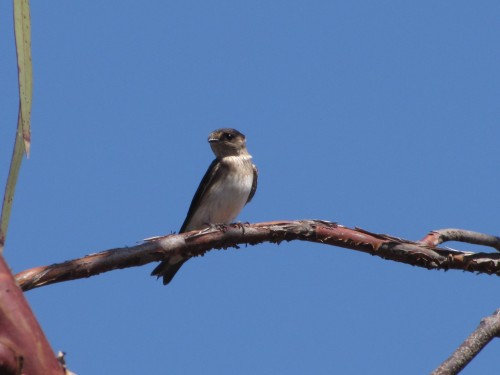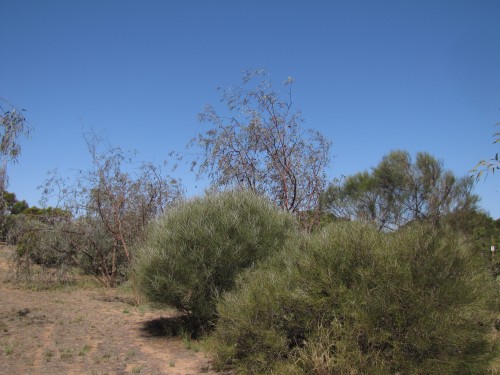Tree Martins all a twitter
A few weeks ago we had a day out with friends of ours. It was my wife’s birthday and after a wonderful lunch in one of the local hotels, we drove from Murray Bridge down south to Wellington. We had a twenty-minute wait to cross the River Murray on the local ferry; for some reason, we struck a very busy time. Driving off the ferry and heading east towards Tailem Bend for about a kilometre we turned off to the left. Several hundred metres on we came to the Pangarinda Botanic Gardens, one of our favourite places to visit near where we live.
These gardens, formerly known as an arboretum, are extensive plantings over 12 hectares of Australian native plants. This is always of particular interest to my wife – you can visit her site Mallee Native Plant Nursery here. While our visit coincided with the latter part of a very hot and dry summer, there was still a good variety of plants flowering. Late winter and early spring are certainly the best times to visit.
I have also found that wherever one finds extensive stands of Australian plants, there is also a good chance of a pleasing variety of birds. We found a newly installed picnic table to enjoy an afternoon cuppa and some birthday cake. While we sat there enjoying the bright, sunny day and gentle breeze, I was able to make a good list of birds seen and heard.
One of the bird species I quickly saw was the Tree Martin. A loose flock of about 50 or 60 martins were swooping and soaring overhead and over one particular group of eucalyptus trees about 50 metres away. After enjoying our cuppa my friend Keith and I wandered over to get a closer look. We could see that many of the martins were perching on several trees. Now I immediately thought that this was a good opportunity to get some close-up photos of this species. Usually, I only get to see this species on the wing, usually high overhead, not a good way of getting photos of this small species. They also fly very quickly.
I was able to approach to within about 10 metres of the tree and I managed to take a series of lovely photos as shown in today’s post (see above and below). While I have seen individuals and even a small group landing near to each other in a tree or on electricity wires, this is the first time I have seen such large numbers all settling near to one another. I am not sure why they were doing this. Then after a minute or so they would all take off again for a minute or two, before settling in the trees again. Perhaps they were just letting their food settle; there were plenty of insects on the wing that day so it was a feast for them, I guess.
Further reading:
Fairy Martins
While outside in the garden earlier today my attention was suddenly attracted by a small group of swallow like birds flying high above the house.
I didn’t have time to grab the binoculars or the camera, so I can’t be sure what they were. I’m guessing that they were either Fairy Martins or Tree Martins. Both species spend winter in northern Australia and start to appear in the southern regions about now.
Looking through my field guides I’m drawn to the conclusion that I probably saw Fairy Martins. While they are quite common in the area for most of the spring and summer, I don’t see them very often over our house, so it was a special treat. It is more common to see Welcome Swallows here as they are resident here all year round.
Click here to see a photo of a Fairy Martin taken by someone else.
Further reading:
A question about swallows
Today I received an interesting question about swallows from a reader:
I have a few questions about swallows and I was wondering if you could help me. I live right on the beach, at Dolphin Sands, Swansea, Tasmania. With Freycinet National Park and the Great Oyster Bay sanctuary we have the perfect place for wildlife. I was told that swallows always appear on the first few days of Spring, or pretty close to it and that they migrate as far as Siberia. Is this true? Also I was told that a pair will always return to the same nesting spot they had the previous year and that they mate for life. Is any of this true? I’d like to find out much more about these lovely little birds. Can you offer any suggestions?
Thanks
Bronwyn
This is my answer to Bronwyn:
It depends on which species of swallow you are seeing.
There are six species of swallows and martins to be found in Australia.
Only two are generally present in Tasmania.
The Welcome Swallow is common throughout eastern and southern Australia, including Tasmania. They have a rusty brown throat and on the forehead. In flight the tail is deeply forked. They normally migrate north in autumn and winter to SE Queensland (wise birds). They return to breed in the spring and early summer. They make a bowl shaped mud nest about the size of a soup bowl, often under wharves, bridges, verandas, eaves and other made structures, including boats. (They often use house boats on the River Murray here in SA)
The other species found in Tasmania is the Tree Martin. They are smaller than the Welcome Swallow, with greyish wings and back and whitish underparts. The tail is only slightly forked. They tend to nest in tree hollows and sometimes holes in cliffs or even holes and ventilators in buildings. They migrate north in Feb-May and return July to October. They are found in Indonesia and PNG as well.
None of our swallows migrate to Siberia. On the other hand, many of our small wading birds do go to the Arctic Circle to breed during our winter. That’s a topic far too big for this article.
Welcome Swallows tend to be monogamous except there is some evidence in Tasmania that they may change partners from year to year (and even within one breeding season). Nest sites are often reused, being refurbished from one breeding attempt to the next. Pair bonding in Tree Martins is not known. In fact there are few detailed breeding studies of this species.
Other readers from Tasmania might care to add further comments. I’ve never been birding in Tasmania so I’ve had to rely entirely on my reference library for this information.
Reference:
Handbook of Australian, New Zealand and Antarctic Birds volume 7, Melbourne, Oxford University Press.
